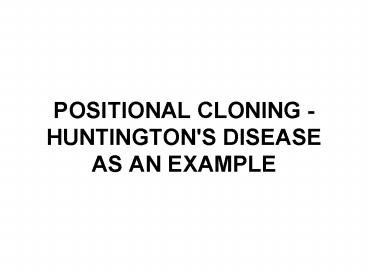POSITIONAL CLONING HUNTINGTON'S DISEASE AS AN EXAMPLE - PowerPoint PPT Presentation
1 / 51
Title:
POSITIONAL CLONING HUNTINGTON'S DISEASE AS AN EXAMPLE
Description:
POSITIONAL CLONING - HUNTINGTON'S DISEASE AS AN EXAMPLE ... Objective: Finding a probe that uncovered an RFLP that was linked to Huntington's disease. ... – PowerPoint PPT presentation
Number of Views:792
Avg rating:3.0/5.0
Title: POSITIONAL CLONING HUNTINGTON'S DISEASE AS AN EXAMPLE
1
POSITIONAL CLONING - HUNTINGTON'S DISEASE AS AN
EXAMPLE
2
- Inheritance pattern - dominant autosomal
- Entirely penetrant and fatal
- Frequency - about 1/10,000 live births
- Late onset - age 35 to 45
- No biochemical defect known, until very recently
- No methods of treatment
- Because of late onset, many have children before
symptoms appear
3
Influence of the Wexler family
4
(No Transcript)
5
Hereditary Disease Foundation
6
Families with a history of Huntington's disease
- Indiana University maintains a National Research
Roster for Huntington's Patients - Large family with a history of Huntington's
disease discovered living on shore of lake
Maracaibo in Venezuela
7
(No Transcript)
8
(No Transcript)
9
For both families with a history of Huntington's
disease
- Blood samples taken from each member
- Permanent cell lines established
- Each family member analyzed by a neurologist for
disease symptoms - Paternity verified
10
(No Transcript)
11
Objective Finding a probe that uncovered an RFLP
that was linked to Huntington's disease.
12
1981 - Gusella's group started with a group of
anonymous probes that uncovered RFLPs - very few
available.
13
They were incredibly lucky - the 12th probe they
tried -called G8 - indicated linkage.
14
(No Transcript)
15
(No Transcript)
16
- Disease associated with the A haplotype in the
American family and the C haplotype in the
Venezuelan family.
17
LOD Scores
18
1983 - G8 (also called D4S10) mapped
approximately 4 cM from the HD locus.
- It took 10 more years to clone the gene. Why?
19
1986-87 DNA markers were used and D4S10 was
localized by in situ hybridization and somatic
cell genetics to chromosome region 4p16.3
20
(No Transcript)
21
Further linkage studies for isolating HD
22
Further linkage studies for isolating HD
23
Further linkage studies for isolating HD
24
Identification of Putative Coding Sequences
25
Exon Trapping
26
Use trapped exons to identify candidate genes
from cDNAs
27
(No Transcript)
28
Four transcripts were analyzed.
29
IT15 - Huntingtin
30
Repeat Sequence Diseases
31
Implications
- No cure yet
- Testing is possible
- Ethical issues arise
32
Cystic fibrosis
- Autosomal recessive
- Not late onset
- Average life expectancy 27 years
- Treatment but no cure
33
About 1/20 to 1/25 Caucasians are carriers of the
defective gene (two carriers have to mate to
produce an affected individual). Why is the
prevalence of this defect so high?
34
(No Transcript)
35
Pedigree Analysis
- A loosely linked RFLP marker was found.
- By in situ hybridization, this marker and
therefore the CF gene were mapped to chromosome 7.
36
Further RFLP markers known to be located on
chromosome 7 were then tested for linkage to
CF.Two markers were found that flanked CF, met
and D7S8 but they were 1600 kb apart.
Eventually two more closely linked markers were
found that narrowed the region to about 500 kb.
37
Cloning the cystic fibrosis gene
D788
7q31
met
38
Step 1 Chromosome walking to make a contig
probe for 1st step
met
39
(No Transcript)
40
In the case of the CF gene, 7 jumps of 50 to 75
kb were made with each arrival point then serving
as a new origin for chromosome walking.
41
Step 2 Identification of candidate genes Zoo
blot
C
A
B
D
H M D
H M D
H M D
H M D
H human genomic DNA M mouse genomic DNA D
Drosophila genomic DNA
42
Step 2 Identification of candidate genes
Northern blots
L lung mRNA B brain mRNA T testis mRNA
43
(No Transcript)
44
- The map position agreed with the linkage data
- The probe had a CpG island at the start of the
coding sequence - The gene was detected in Northern blots using RNA
extracted from the "correct" tissue, in this case
cultured epithelial (sweat gland) cells
45
(No Transcript)
46
(No Transcript)
47
(No Transcript)
48
Diagnostic tests are available, but extensive
testing is necessary because there are so many
different mutations.
49
Since the function of the gene is known,
treatment strategies can be devised.
50
Gene therapy
- Insert CFTR gene in adenovirus vector.
- Virus is used to infect CF patient by inhalation.
- Virus inserts itself into lung cells, where gene
functions normally.
51
Why is disease so prevalent?
- Selective advantage of heterozygotes?
- Big gene, many mutations































